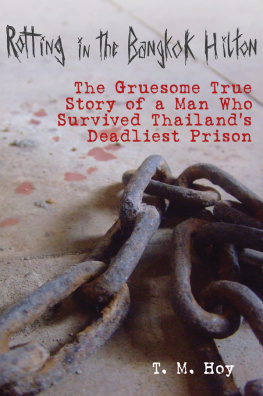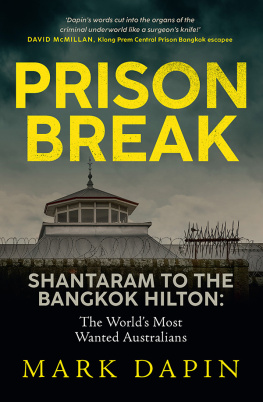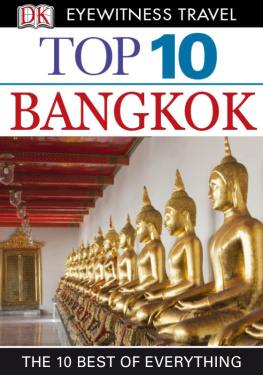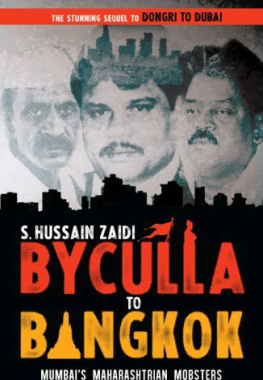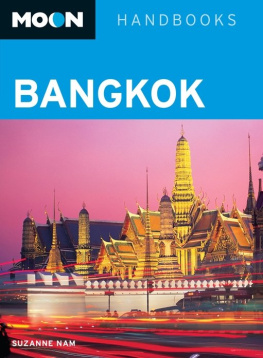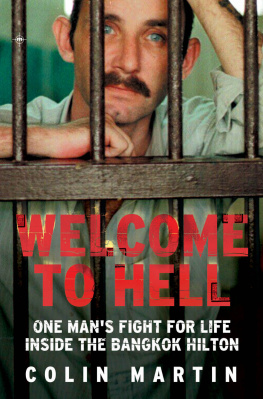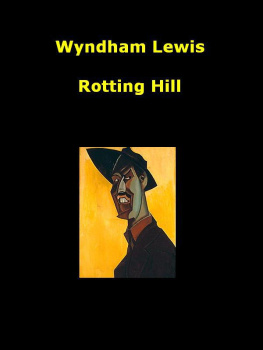T.M. Hoy - Rotting in the Bangkok Hilton
Here you can read online T.M. Hoy - Rotting in the Bangkok Hilton full text of the book (entire story) in english for free. Download pdf and epub, get meaning, cover and reviews about this ebook. year: 2012, publisher: Skyhorse Publishing, Inc., genre: Non-fiction. Description of the work, (preface) as well as reviews are available. Best literature library LitArk.com created for fans of good reading and offers a wide selection of genres:
Romance novel
Science fiction
Adventure
Detective
Science
History
Home and family
Prose
Art
Politics
Computer
Non-fiction
Religion
Business
Children
Humor
Choose a favorite category and find really read worthwhile books. Enjoy immersion in the world of imagination, feel the emotions of the characters or learn something new for yourself, make an fascinating discovery.
- Book:Rotting in the Bangkok Hilton
- Author:
- Publisher:Skyhorse Publishing, Inc.
- Genre:
- Year:2012
- Rating:4 / 5
- Favourites:Add to favourites
- Your mark:
- 80
- 1
- 2
- 3
- 4
- 5
Rotting in the Bangkok Hilton: summary, description and annotation
We offer to read an annotation, description, summary or preface (depends on what the author of the book "Rotting in the Bangkok Hilton" wrote himself). If you haven't found the necessary information about the book — write in the comments, we will try to find it.
Rotting in the Bangkok Hilton — read online for free the complete book (whole text) full work
Below is the text of the book, divided by pages. System saving the place of the last page read, allows you to conveniently read the book "Rotting in the Bangkok Hilton" online for free, without having to search again every time where you left off. Put a bookmark, and you can go to the page where you finished reading at any time.
Font size:
Interval:
Bookmark:

Copyright 2012 by T. M. Hoy
All Rights Reserved. No part of this book may be reproduced in any manner without the express written consent of the publisher, except in the case of brief excerpts in critical reviews or articles. All inquiries should be addressed to Skyhorse Publishing, 307 West 36th Street, 11th Floor, New York, NY 10018.
The material in this book is for general information purposes only. The author and the publisher assume no responsibility or liability for any consequence resulting from any action or inaction taken based on or made in reliance on the information or material in this book.
Skyhorse Publishing books may be purchased in bulk at special discounts for sales promotion, corporate gifts, fund-raising, or educational purposes. Special editions can also be created to specifications. For details, contact the Special Sales Department, Skyhorse Publishing, 307 West 36th Street, 11th Floor, New York, NY 10018 or .
Skyhorse and Skyhorse Publishing are registered trademarks of Skyhorse Publishing, Inc., a Delaware corporation.
Visit our website at www.skyhorsepublishing.com.
10 9 8 7 6 5 4 3 2 1
Library of Congress Cataloging-in-Publication Data
Hoy, T. M.
Rotting in the Bangkok Hilton : the gruesome true story of a man who survived Thailands deadliest prison / T.M. Hoy.
p. cm.
ISBN 978-1-61608-688-6 (hardcover : alk. paper)
1. Hoy, T. M. 2. Prisoners--Thailand--Bangkok--Biography. 3. Prisoners, Foreign-
Thailand--Bangkok--Biography. 4. Prisons--Thailand--Bangkok--Biography. 5. Criminal justice, Administration of--Thailand--Bangkok. I. Title.
HV9800.55.Z8B3623 2011
365.6092--dc23
[B]
2011045688
Printed in the United States of America

P eople will write a book for many reasons. I wrote this one to earn my way out of prison. The profits from this book should be enough to pay the bribe required to secure a pardon and to hire a lawyer to see that it is honored in the United States. In a full circle of irony, my hellish time in Thai prison, in written form, may release me.
My perspective has changed dramatically since I was first incarcerated in Thailand, and these stories reflect that change. They are purged of bitterness, hatred, and a range of emotions that dominated my experience. Memory is a fluid, transient thing, forever shifting the minds contents in unpredictable ways. Within the limitations of my porous, fallible recall, and subject to the new filters acceptance and closure have placed over my inner eye, these stories are as true as I could make them.
The stories themselves are the memories which are most insistent; the things that refused to be banished from my consciousness. When I think of them, each story is accompanied by a host of others, like a flock of birds harrying a fishermans loaded net. Those innumerable moments of bright, shining evil must remain in obscurity; I have neither the patience nor inclination to commit more of them to writing.
It is a curious feature of humans that pain and misery, lived vicariously, are enormously popular. For a time, we breathe deeply and absorb the suffering of others, knowing all the while that whatever our troubles may be, they seem far less than those of the characters we follow on the pages in our hands.
Enjoy this collection of humiliation, degradation, fear, and agony. But remember, as Nietzsche so wisely noted; when you stare into the abyss, the abyss also stares into you.
T. M. Hoy
October 2003
Tucson, Arizona

C hiang Mai Remand Prison in northern Thailand is a small place, far too small for the immensity of sorrow and misery it contained. Its whitewashed brick outer walls enclosed a square space about the size of a football field. Of the seven main buildings within the walls, two were used by the prison administrators and guards as office space, and another two were solidly constructed, two-story concrete dormitories for permanent prisoners. The remaining two buildingsbuilt on stiltsheld the bulk of the prisoners. The upper floor housed the pre-trial inmates; the ground floors were reserved for the extensive furniture factories consuming illegally logged teak. The seventh building was the hospital, a barren two-story box used as storage for the dead and dying, bereft of any medical care.
This orderly prison, laid out as a series of rectangular structures, a legacy of the Japanese occupation during WWII, was crowded with more than four times the number of prisoners for which it was designed. 1,300 men were crammed into a space intended to hold barely 300.
Overcrowding was the least of its deficiencies compared to the host of other horrors it held; the incessant roar of poorly maintained wood saws and grinders worked from dawn till dusk, shredding nerves and yielding migraine headaches daily.
The toxic fumes from the wood lacquering workshops engulfed the compound with poisonous air, leaving lungs on fire and people choking for breath.
The utter absence of medical care; the clever, vicious torments practiced by the guards; the bestially bad foodall combined to qualify the prison for a prominent spot in one of the lower circles of Hell.
Permeating everything, a malign presence, was the tropical climate. It smothered you in a hot, wet blanket of humidity and left you a limp, soggy rag. In the rainy season, molds and mildews sprang from the walls, and flu-like viruses became epidemic. By contrast, the dry season drained non-natives of energy, the sun knocking you prostrate.
Bad as it was, none of this concerned me greatly. I was busy grappling with the fact that I was dying.
There was little doubt that I would die, it was only a question of when. I hadnt eaten in two weeks; and thiscompounded by the dysentery brought on by drinking the foul river water given to prisonershad reduced me to a stick figure, a loose bag of bones.
The food provided twice a day by the prison officials for prisoners consisted of rice and soup. The rice was the sticky or glutinous variety and was served as either rock-hard bricks or crawling with maggot-like weevils. Local farmers donated the rice for a tax write-off and gave the prison the rice used for animal feed that had gone bad with rot or insect infestation.
The soup was another fraudulent scheme run by the thrifty prison administrators who pocketed the government-allocated food budget. The prison had a contract with the peasants who were employed to clean a local farmers market site. They swept up the fish entrails and bones, along with all the litter and rotten vegetables into rusty fifty-gallon barrels. Instead of dumping it, they dropped these off at the prison, where the contents were poured into cauldrons and boiled. The resultant swill was served as soup.
The only alternative to prison food was a small private kitchen run by enterprising ChineseThai prisoners. It occupied a room next to the guards offices and cooked simple dishes: fried rice, noodles; and carried bread and muffins in from a nearby bakery. Unfortunately, they delighted in torturing foreigners, and the only food I was allowed to purchase were three banana bread muffins per day. The guards had decided to cut off even that meager food supply, and starvation became inevitable.
The guards animosity towards me wasnt personal. It was an uncontrollable primal thing that was extended to the dozen farangs at the prison. This hatred of the rich farangs (derogatory Thai slang for foreigners) that came to their country was understandable. In their eyes, we were arrogant intruders that mocked their abject poverty and demanded their servitude. Most of the guards worked second jobs in the tourist industry, work they considered demeaning.
Font size:
Interval:
Bookmark:
Similar books «Rotting in the Bangkok Hilton»
Look at similar books to Rotting in the Bangkok Hilton. We have selected literature similar in name and meaning in the hope of providing readers with more options to find new, interesting, not yet read works.
Discussion, reviews of the book Rotting in the Bangkok Hilton and just readers' own opinions. Leave your comments, write what you think about the work, its meaning or the main characters. Specify what exactly you liked and what you didn't like, and why you think so.

